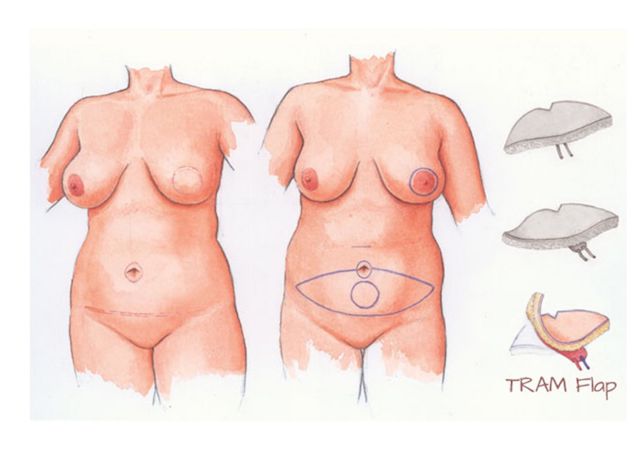TRAM Flap Reconstruction
Breast cancer is the commonest cancer in females. One out of nine females eventually get breast cancer. If you develop a treatable breast cancer your will have to undergo either a mastectomy (Removal of the breast) Lumpectomy (removal of the part of the breast containing the tumor). Removal of the breast result in a flat chest. To overcome this your breast surgeon might offer you breast reconstruction. There are different methods of breast reconstructions and TRAM Flap or Rectus Abdominis Muscle Flap is one of the commonly used reconstruction method. The procedure was originally described by Dr. Carl R Hartramf in 1980.
What is TRAM Flap
A flap is a piece of tissue taken with its blood supply. TRAM flap (Rectus abdomines muscle flap) is a piece of muscle and surrounding tissues taken from your tummy wall.
Types of TRAM Flaps
There are two main types of TRAM flaps.
Free TRAM Flap
In free TRAM Flap blood vessels supplying the flap are detached from the body and reattached to new blood vessels near the breast using micro surgical techniques.. This is technically more demanding but gives better cosmetic outcome.
In pedicled TRAM flaps tissue is taken to the breast without detaching the original blood vessels.
How is TRAM Flap Performed
Before doing the TRAM flap your surgeon will remove your breast with the cancer. This will be either Nipple sparing mastectomy (Removing the breast while preserving your nipple and skin), Skin sparing mastectomy ( Removal of the breast and nipple while preserving the skin) or simple mastectomy ( complete removal of the breast).The type of mastectomy you get depends on the size of the cancer and how close it is to your nipple.
Once the mastectomy is completed your surgeon will take a piece of tissue from your tummy wall below your belly button. This is done carefully while preserving the blood vessels. This piece of tissue is taken underneath your skin to the chest to reconstruct a new breast.
The surgeon will repair the defect in the tummy wall with a mesh (a synthetic net) and cover it with skin.
Contraindications for TRAM Flap
Previous multiple abdominal surgeries
Planning to get pregnant
How top prepare for TRAM Flap
Complications of TRAM Flap
1.Pain
TRAM Flap involve a lot of tissue dissections. So it can cause significant pain during the first few after surgery. Your doctor will give you adequate pain killers to overcome this
2.Flap necrosis ( Die)
Tram flap is a technically demanding surgery. Sometimes blood supply to the flap can get compromised. If this happens flap will die and your doctor will remove the flap.
4. Bleeding
Bleeding may occur during surgery
4.Infections
Infections are more common if you are a Diabetic or had chemotherapy before surgery
5.Incisional hernia
TRAM Flap weakens your tommy wall and that can leads to hernia.
6.Skin necrosis
7.Altered breast sensation
Recovery after TRAAM Flap breast reconstruction
You will have to stay in the hospital for 3 to 5 days after surgey. During this time your doctor will monitor your flap and provide you with adequate pain killers
You will have drains inserted to the breast and flap site and these will be kept or few days for any fluid to come out.
Full recovery will take about weeks and you can get back to your day today activitie gradually.
Since your tummy muscles are week you should avoid heavy weight lifting at least during the initial period .
Alternatives for TRAM Flap for breast reconstruction
DIEAP – Deep Inferior epigastric muscle flap
Latissimus dorsi muscle flap
Implant based breast reconstruction
SIEA – superficial inferior epigastric artery flap

